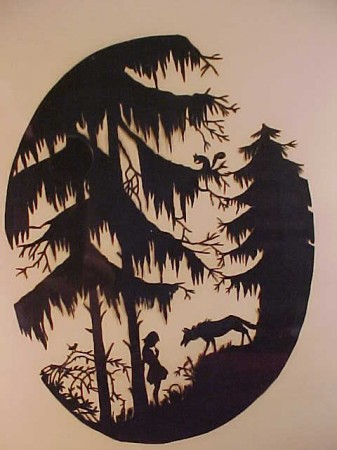 I have for about a year now placed these three short “notifications” at the bottom of each page! So I have had to move them forward as I am really getting tired of copying them and sending them back to people as an answer to their “stein value?” questions.
I have for about a year now placed these three short “notifications” at the bottom of each page! So I have had to move them forward as I am really getting tired of copying them and sending them back to people as an answer to their “stein value?” questions.
[5/12]
NOW, STILL WISH TO CONTACT ME? STEVE (STEPHEN) =
“ROTKÖPPCHEN”, OR “LITTLE RED CAP” (RED RIDING HOOD)…. by the Brother’s Grimm (as depicted on German Kinderkruge.) First a word about German/English terminology: The German word for children (pl.) is “Kinder”; the word for stein is Krug (pl., Krüge or Kruege) and the word for children’s stein is Kinderkrug (pl., Kinderkrüge or Kinderkruege). Although it is frequently useful to adopt German words for English expression, thereby retaining a sense of context, culture and history for the term or expression, we must be careful not to construct new words using standard English practice, which would thereby have no legitimacy in either language. In German, all nouns are capitalized, and plurals are formed by special rules, not simply by adding an “s”. In other words– • “Kinder” (children), yes; “kinder”, no. • “Kinderkrug (children’s stein), yes; “kinderkrug”, no. • “Kinderkrüg” or “Kinderkruege”, yes; “Kinderkrugs”, no. That said, for convenience sake in this article I have coined the word “Kinder” (and its plural, Kinders) to mean steins or mugs specifically made in Germany for children. Above, by Walt Vogdes, from the preface of the article “German Kinderkrug” (2004) Once upon a time there was a dear little girl who was loved by every one who looked at her, but most of all by her grandmother, and there was nothing that she would not have given to the child. Once she gave her a little cap of red velvet, which suited her so well that she would never wear anything else. So she was always called little little red cap.  [Little ‘Red Cap’ (Riding Hood) and her mother getting grandmother’s gifts together.] One day her mother said to her, come, little red-cap, here is a piece of cake and a bottle of wine. Take them to your grandmother, she is ill and weak, and they will do her good. Set out before it gets hot, and when you are going, walk nicely and quietly and do not run off the path, or you may fall and break the bottle, and then your grandmother will get nothing. And when you go into her room, don’t forget to say, good-morning, and don’t peep into every corner before you do it. I will take great care, said little red-cap to her mother, and gave her hand on it.
[Little ‘Red Cap’ (Riding Hood) and her mother getting grandmother’s gifts together.] One day her mother said to her, come, little red-cap, here is a piece of cake and a bottle of wine. Take them to your grandmother, she is ill and weak, and they will do her good. Set out before it gets hot, and when you are going, walk nicely and quietly and do not run off the path, or you may fall and break the bottle, and then your grandmother will get nothing. And when you go into her room, don’t forget to say, good-morning, and don’t peep into every corner before you do it. I will take great care, said little red-cap to her mother, and gave her hand on it. 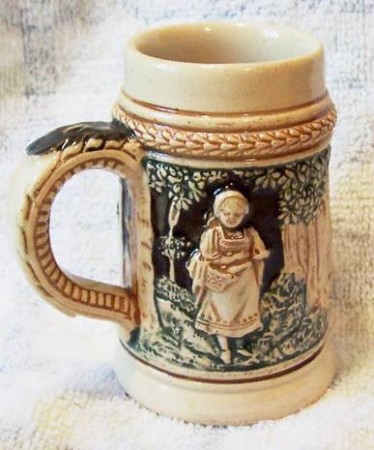 [Little Red Cap walking through the woods going to grandmother’s house.] The grandmother lived out in the woods, half a league from the village, and just as little red-cap entered the woods, a wolf met her. Red-cap did not know what a wicked creature he was, and was not at all afraid of him. “Good-day, little red-cap,” said he. “Thank you kindly, wolf.”
[Little Red Cap walking through the woods going to grandmother’s house.] The grandmother lived out in the woods, half a league from the village, and just as little red-cap entered the woods, a wolf met her. Red-cap did not know what a wicked creature he was, and was not at all afraid of him. “Good-day, little red-cap,” said he. “Thank you kindly, wolf.”
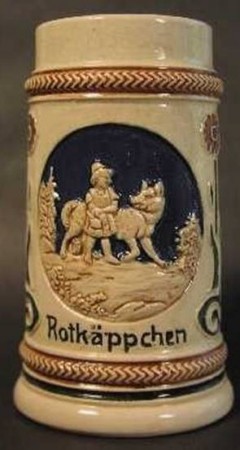
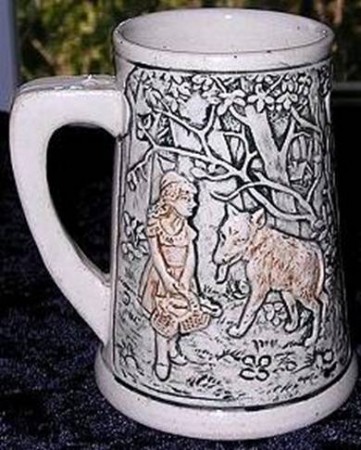
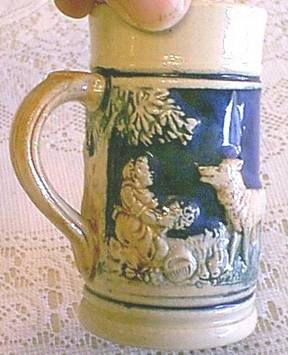
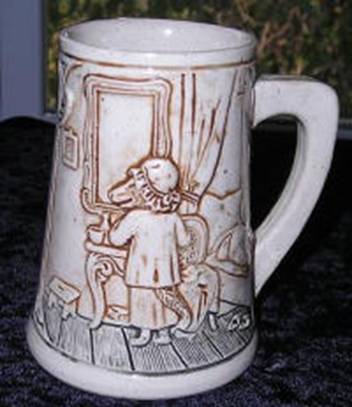
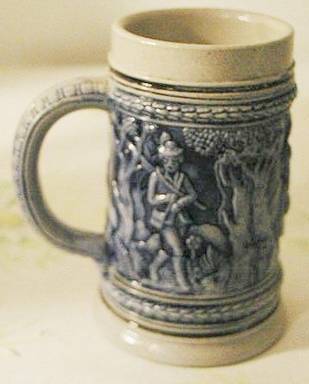
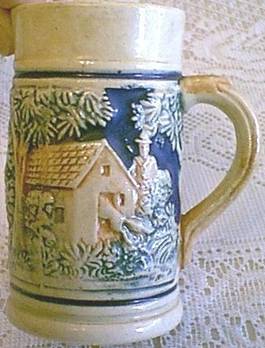
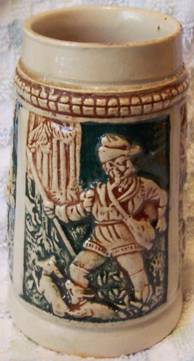
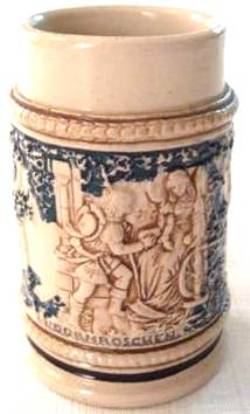 [The front scene of a 3 ¾ inch tall kinderkruge entitled: “Dornroschen,” is Sleeping Beauty sitting in chair with a spinning wheel next to her. Her prince has come to wake her up after 100 years of sleep.]
[The front scene of a 3 ¾ inch tall kinderkruge entitled: “Dornroschen,” is Sleeping Beauty sitting in chair with a spinning wheel next to her. Her prince has come to wake her up after 100 years of sleep.]
“A long time ago there were a king and queen who said every day, “Ah, if only we had a child,” but they never had one.
But it happened that once when the queen was bathing, a frog crept out of the water on to the land, and said to her, “Your wish shall be fulfilled, before a year has gone by, you shall have a daughter.” What the frog had said came true, and the queen had a little girl who was so pretty that the king could not contain himself for joy, and ordered a great feast. He invited not only his kindred, friends and acquaintances, but also the wise women, [1] in order that they might be kind and well-disposed towards the child. There were thirteen of them in his kingdom, but, as he had only twelve golden plates for them to eat out of, one of them had to be left at home. [1] The feast was held with all manner of splendor and when it came to an end the wise women bestowed their magic gifts upon the baby – one gave virtue, another beauty, a third riches, and so on with everything in the world that one can wish for. When eleven of them had made their promises, suddenly the thirteenth came in. She wished to avenge herself for not having been invited, and without greeting, or even looking at anyone, she cried with a loud voice, “The king’s daughter shall in her fifteenth year prick herself with a spindle, and fall down dead.” And, without saying a word more, she turned round and left the room. They were all shocked, but the twelfth, whose good wish still remained unspoken, came forward, and as she could not undo the evil sentence, but only soften it, she said, it shall not be death, but a deep sleep of a hundred years, into which the princess shall fall. The king, who would fain keep his dear child from the misfortune, gave orders that every spindle in the whole kingdom should be burnt. 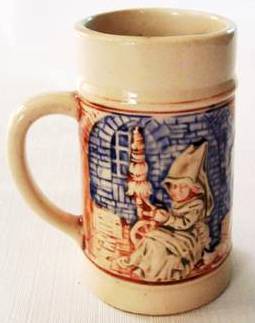 [Spindles such as these were outlawed and burned after the king got his warning from the thirteenth woman [a witch.] This scene of the old lady at the top of the tower is shown on a four inch tall “Jo-Mo” kinderkruge (the mug came with that brand of mustard and spices stored inside of it); an unknown maker, but the form No. is 4002.]
[Spindles such as these were outlawed and burned after the king got his warning from the thirteenth woman [a witch.] This scene of the old lady at the top of the tower is shown on a four inch tall “Jo-Mo” kinderkruge (the mug came with that brand of mustard and spices stored inside of it); an unknown maker, but the form No. is 4002.]
 [The right side scene on a multi-colored ¼ liter, lidded kinderkruge. It shows “Beauty” and the old lady and her cat (in the window) in the spinning room at the top of the tower.] “What sort of thing is that, that rattles round so merrily,” said the girl, and she took the spindle and wanted to spin too. But scarcely had she touched the spindle when the magic decree was fulfilled, and she pricked her finger with it.
[The right side scene on a multi-colored ¼ liter, lidded kinderkruge. It shows “Beauty” and the old lady and her cat (in the window) in the spinning room at the top of the tower.] “What sort of thing is that, that rattles round so merrily,” said the girl, and she took the spindle and wanted to spin too. But scarcely had she touched the spindle when the magic decree was fulfilled, and she pricked her finger with it. 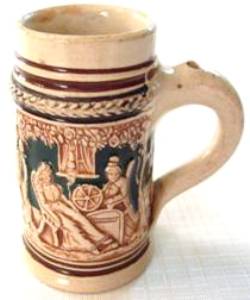 –
– 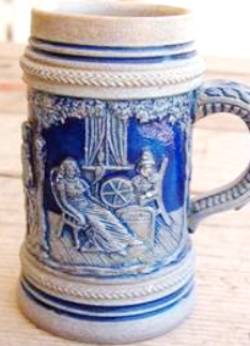 [Two other similar scenes of the spinning room: The scene is on a “mini-kinderkrug”; only 3 ¼ inch tall. The scene shown here to the right is on 4 inch tall gray salt-glazed stoneware kinderkruge with cobalt coloring. As these both were probably not produced by the same stein manufacturer, the illustration used probably came from a sketch book or a print.] And, in the very moment when she felt the prick, she fell down upon the bed that stood there, and lay in a deep sleep. [2] And this sleep extended over the whole palace, the king and queen who had just come home, and had entered the great hall, began to go to sleep, and the whole of the court with them. The horses, too, went to sleep in the stable, the dogs in the yard, the pigeons upon the roof, the flies on the wall, even the fire that was flaming on the hearth became quiet and slept, the roast meat left off frizzling, and the cook, who was just going to pull the hair of the scullery boy, because he had forgotten something, let him go, and went to sleep. And the wind fell, and on the trees before the castle not a leaf moved again.
[Two other similar scenes of the spinning room: The scene is on a “mini-kinderkrug”; only 3 ¼ inch tall. The scene shown here to the right is on 4 inch tall gray salt-glazed stoneware kinderkruge with cobalt coloring. As these both were probably not produced by the same stein manufacturer, the illustration used probably came from a sketch book or a print.] And, in the very moment when she felt the prick, she fell down upon the bed that stood there, and lay in a deep sleep. [2] And this sleep extended over the whole palace, the king and queen who had just come home, and had entered the great hall, began to go to sleep, and the whole of the court with them. The horses, too, went to sleep in the stable, the dogs in the yard, the pigeons upon the roof, the flies on the wall, even the fire that was flaming on the hearth became quiet and slept, the roast meat left off frizzling, and the cook, who was just going to pull the hair of the scullery boy, because he had forgotten something, let him go, and went to sleep. And the wind fell, and on the trees before the castle not a leaf moved again. 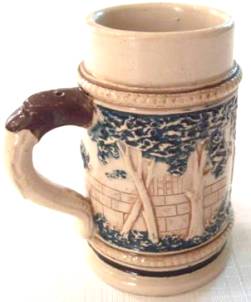 [This scene is from the left side of the “kinder–mug” shown in Photo 1 above (“Dornroschen”). It depicts the trees and thorn thicket growing all around the castle sides for 100 years.]. But round about the castle there began to grow a hedge of thorns, which every year became higher, and at last grew close up round the castle and all over it, so that there was nothing of it to be seen, not even the flag upon the roof. But the story of the beautiful sleeping briar-rose, for so the princess was named, went about the country, so that from time to time kings’ sons came and tried to get through the thorny hedge into the castle. But they found it impossible, for the thorns held fast together, as if they had hands, and the youths were caught in them, could not get loose again, and died a miserable death. After long, long years a king’s son came again to that country, and heard an old man talking about the thorn-hedge, and that a castle was said to stand behind it in which a wonderfully beautiful princess, named briar-rose, had been asleep for a hundred years, and that the king and queen and the whole court were asleep likewise.
[This scene is from the left side of the “kinder–mug” shown in Photo 1 above (“Dornroschen”). It depicts the trees and thorn thicket growing all around the castle sides for 100 years.]. But round about the castle there began to grow a hedge of thorns, which every year became higher, and at last grew close up round the castle and all over it, so that there was nothing of it to be seen, not even the flag upon the roof. But the story of the beautiful sleeping briar-rose, for so the princess was named, went about the country, so that from time to time kings’ sons came and tried to get through the thorny hedge into the castle. But they found it impossible, for the thorns held fast together, as if they had hands, and the youths were caught in them, could not get loose again, and died a miserable death. After long, long years a king’s son came again to that country, and heard an old man talking about the thorn-hedge, and that a castle was said to stand behind it in which a wonderfully beautiful princess, named briar-rose, had been asleep for a hundred years, and that the king and queen and the whole court were asleep likewise. 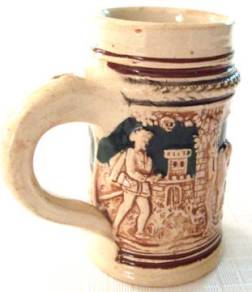 [A 3.5 inch slipware relief kinderkruge. The scene shows the Prince searching for the castle which contained the “Sleeping Beauty” that he heard about from his Grandfather.] He had heard, too, from his grandfather, that many kings, sons had already come, and had tried to get through the thorny hedge, but they had remained sticking fast in it, and had died a pitiful death. Then the youth said, “I am not afraid, I will go and see the beautiful briar-rose.” The good old man might dissuade him as he would, he did not listen to his words. But by this time the hundred years had just passed, and the day had come when briar-rose was to awake again. When the king’s son came near to the thorn-hedge, it was nothing but large and beautiful flowers, which parted from each other of their own accord, and let him pass unhurt, then they closed again behind him like a hedge. [2] [Left side scene on the stein (shown also as Photo 3) shows the Prince cutting his way through the dense thicket to get at the castle he saw in the background.] [See #2 below] In the castle yard he saw the horses and the spotted hounds lying asleep, on the roof sat the pigeons with their heads under their wings. And when he entered the house, the flies were asleep upon the wall, the cook in the kitchen was still holding out his hand to seize the boy, and the maid was sitting by the black hen which she was going to pluck. He went on farther, and in the great hall he saw the whole of the court lying asleep, and up by the throne lay the king and queen. Then he went on still far
[A 3.5 inch slipware relief kinderkruge. The scene shows the Prince searching for the castle which contained the “Sleeping Beauty” that he heard about from his Grandfather.] He had heard, too, from his grandfather, that many kings, sons had already come, and had tried to get through the thorny hedge, but they had remained sticking fast in it, and had died a pitiful death. Then the youth said, “I am not afraid, I will go and see the beautiful briar-rose.” The good old man might dissuade him as he would, he did not listen to his words. But by this time the hundred years had just passed, and the day had come when briar-rose was to awake again. When the king’s son came near to the thorn-hedge, it was nothing but large and beautiful flowers, which parted from each other of their own accord, and let him pass unhurt, then they closed again behind him like a hedge. [2] [Left side scene on the stein (shown also as Photo 3) shows the Prince cutting his way through the dense thicket to get at the castle he saw in the background.] [See #2 below] In the castle yard he saw the horses and the spotted hounds lying asleep, on the roof sat the pigeons with their heads under their wings. And when he entered the house, the flies were asleep upon the wall, the cook in the kitchen was still holding out his hand to seize the boy, and the maid was sitting by the black hen which she was going to pluck. He went on farther, and in the great hall he saw the whole of the court lying asleep, and up by the throne lay the king and queen. Then he went on still far
ther, and all was so quiet that a breath could be heard, and at last he came to the tower, and opened the door into the little room where briar-rose was sleeping. There she lay, so beautiful that he could not turn his eyes away, and he stooped down and gave her a kiss. But as soon as he kissed her, briar-rose opened her eyes and awoke, and looked at him quite sweetly. 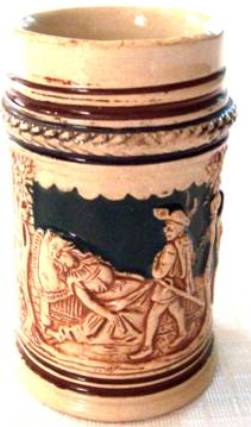 [Front scene of a ‘mini’ kinderkrug, only 3 ¼ inches. It shows the Prince coming up to “Briar Rose who is reclining on a couch] – [3] Then they went down together, and the king awoke, and the queen and the whole court, and looked at each other in great astonishment. And the horses in the courtyard stood up and shook themselves, the hounds jumped up and wagged their tails, the pigeons upon the roof pulled out their heads from under their wings, looked round, and flew into the open country, the flies on the wall crept again, the fire in the kitchen burned up and flickered and cooked the meat, the joint began to turn and sizzle again, and the cook gave the boy such a box on the ear that he screamed, and the maid finished plucking the fowl. And then the marriage of the king’s son with briar-rose was celebrated with all splendor, and they lived contented to the end of their days.”
[Front scene of a ‘mini’ kinderkrug, only 3 ¼ inches. It shows the Prince coming up to “Briar Rose who is reclining on a couch] – [3] Then they went down together, and the king awoke, and the queen and the whole court, and looked at each other in great astonishment. And the horses in the courtyard stood up and shook themselves, the hounds jumped up and wagged their tails, the pigeons upon the roof pulled out their heads from under their wings, looked round, and flew into the open country, the flies on the wall crept again, the fire in the kitchen burned up and flickered and cooked the meat, the joint began to turn and sizzle again, and the cook gave the boy such a box on the ear that he screamed, and the maid finished plucking the fowl. And then the marriage of the king’s son with briar-rose was celebrated with all splendor, and they lived contented to the end of their days.”
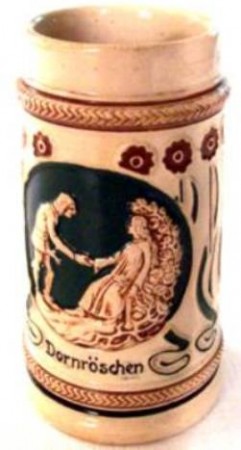
[3] In the earliest versions of this tale “Beauty” falls asleep sitting in a chair, not a couch. This is represented above in the first photo and the last. As this kindermug was produced way after Grimm’s versions become “The Rule”, the earlier version could have be in the mold artist’s mind. or more than likely a space saver, a couch being too big for the oval. “RATTENFANGEN” (THE PIED PIPER), 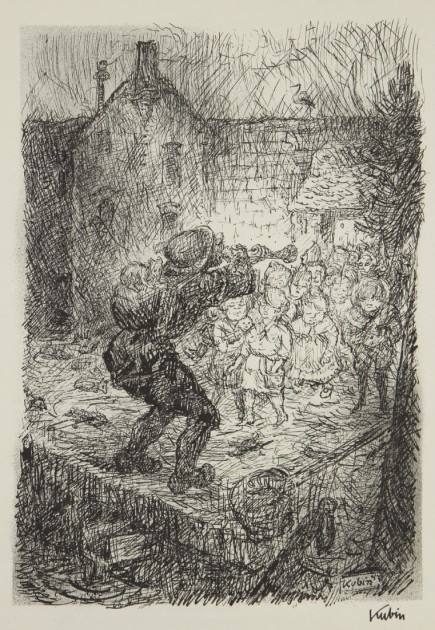 THE PIED PIPER –1877 Leitmeritz- Böhmen – 1959 Zwickledt am Inn – ‘Rattenfänger’
THE PIED PIPER –1877 Leitmeritz- Böhmen – 1959 Zwickledt am Inn – ‘Rattenfänger’
The Children of Hameln, by Jacob and Wilhelm Grimm
The Children of Hameln Jacob and Wilhelm Grimm In the year 1284 a mysterious man appeared in Hameln. He was wearing a coat of many colored, bright cloth, for which reason he was called the Pied Piper. He claimed to be a rat catcher, and he promised that for a certain sum that he would rid the city of all mice and rats. The citizens struck a deal, promising him a certain price. The rat catcher then took a small fife from his pocket and began to blow on it. Rats and mice immediately came from every house and gathered around him. When he thought that he had them all he led them to the River Weser where he pulled up his clothes and walked into the water. The animals all followed him, fell in, and drowned. Now that the citizens had been freed of their plague, they regreted having promised so much money, and, using all kinds of excuses, they refused to pay him. Finally he went away, bitter and angry. He returned on June 26, Saint John’s and Saint Paul’s Day, early in the morning at seven o’clock (others say it was at noon), now dressed in a hunter’s costume, with a dreadful look on his face and wearing a strange red hat. He sounded his fife in the streets, but this time it wasn’t rats and mice that came to him, but rather children: a great number of boys and girls from their fourth year on. Among them was the mayor’s grown daughter. The swarm followed him, and he led them into a mountain, where he disappeared with them. All this was seen by a babysitter who, carrying a child in her arms, had followed them from a distance, but had then turned around and carried the news back to the town. The anxious parents ran in droves to the town gates seeking their children. The mothers cried out and sobbed pitifully. Within the hour messengers were sent everywhere by water and by land inquiring if the children — or any of them — had been seen, but it was all for naught. In total, one hundred thirty were lost. Two, as some say, had lagged behind and came back. One of them was blind and the other mute. The blind one was not able to point out the place, but was able to tell how they had followed the piper. The mute one was able to point out the place, although he [or she] had heard nothing. One little boy in shirtsleeves had gone along with the others, but had turned back to fetch his jacket and thus escaped the tragedy, for when he returned, the others had already disappeared into a cave within a hill. This cave is still shown. Until the middle of the eighteenth century, and probably still today, the street through which the children were led out to the town gate was called the bunge-lose (drumless, soundless, quiet) street, because no dancing or music was allowed there. Indeed, when a bridal procession on its way to church crossed this street, the musicians would have to stop playing. The mountain near Hameln where the the children disappeared is called Poppenberg. Two stone monuments in the form of crosses have been erected there, one on the left side and one on the right. Some say that the children were led into a cave, and that they came out again in Transylvania. The citizens of Hameln recorded this event in their town register, and they came to date all their proclamations according to the years and days since the loss of their children. According to Seyfried the 22nd rather than the 26th of June was entered into the town register. The following lines were inscribed on the town hall: In the year 1284 after the birth of Christ From Hameln were led away One hundred thirty children, born at this place Led away by a piper into a mountain. And on the new gate was inscribed: Centum ter denos cum magus ab urbe puellos duxerat ante annos CCLXXII condita porta fuit. [This gate was built 272 years after the magician led the 130 children from the city.] In the year 1572 the mayor had the story portrayed in the church windows. The accompanying inscription has become largely illegible. In addition, a coin was minted in memory of the event. [Source: Jacob and Wilhelm Grimm, “Die Kinder zu Hameln,” Deutsche Sagen (Berlin: In der Nicolaischen Buchhandlung, 1816), no. 244, pp. 330-33. In following editions this legend is numbered 245.] 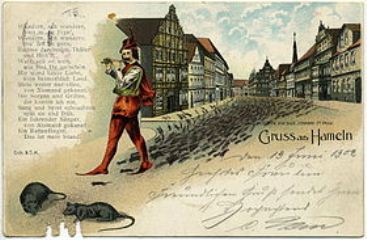 The Pied Piper of Hamelin (German: Rattenfänger von Hameln) is the subject of a legend concerning the departure or death of a great many children from the town of Hamelin (Hameln), Lower Saxony, Germany, in the Middle Ages. The earliest references describe a piper, dressed in pied (multicolored) clothing, leading the children away from the town never to return. In the 16th century the story was expanded into a full narrative, in which the piper is a rat-catcher hired by the town to lure rats away with his magic pipe. When the citizenry refuses to pay for this service, he retaliates by turning his magic on their children, leading them away as he had the rats. This version of the story spread as a fairy tale. This version has also appeared in the writings of, among others, Johann Wolfgang von Goethe, the Brothers Grimm and Robert Browning.
The Pied Piper of Hamelin (German: Rattenfänger von Hameln) is the subject of a legend concerning the departure or death of a great many children from the town of Hamelin (Hameln), Lower Saxony, Germany, in the Middle Ages. The earliest references describe a piper, dressed in pied (multicolored) clothing, leading the children away from the town never to return. In the 16th century the story was expanded into a full narrative, in which the piper is a rat-catcher hired by the town to lure rats away with his magic pipe. When the citizenry refuses to pay for this service, he retaliates by turning his magic on their children, leading them away as he had the rats. This version of the story spread as a fairy tale. This version has also appeared in the writings of, among others, Johann Wolfgang von Goethe, the Brothers Grimm and Robert Browning. 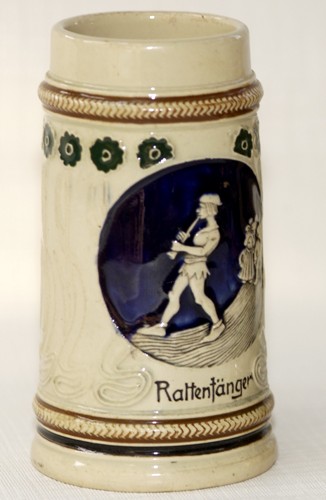 [.25 liter pottery “Kinder” mug showing the “Ratenfänger. (Rat catcher.)” This version is one that is the least enameled of any of the fairy tale story that were produced by this firm . Those green roundels at the top of the drum are supposed to be flowers and the vertical stems in light relief are most often found painted green.] The story may reflect a historical event in which Hamelin lost its children. Theories have been proposed suggesting that the Pied Piper is a symbol of the children’s death by plague or catastrophe. Other theories liken him to figures like Nicholas of Cologne, who is said to have lured away a great number of children on a disastrous Children’s Crusade. A recent theory ties the departure of Hamelin’s children to the Ostsiedlung, in which a number of Germans left their homes to colonize Eastern Europe. It is also a story about paying those who are due. The earliest mention of the story seems to have been on a stained glass window placed in the Church of Hamelin c. 1300. The window was described in several accounts between the 14th century and the 17th century. It was destroyed in 1660. Based on the surviving descriptions, a modern reconstruction of the window has been created by Hans Dobbertin (historian). It features the colorful figure of the Pied Piper and several figures of children dressed in white. This window is generally considered to have been created in memory of a tragic historical event for the town. Also, Hamelin town records start with this event. The earliest written record is from the town chronicles in an entry from 1384 which states: “It is 100 years since our children left.” Although research has been conducted for centuries, no explanation for the historical event is agreed upon. In any case, the rats were first added to the story in a version from c. 1559 and are absent from earlier accounts. The above was taken from : http://en.wikipedia.org/wiki/Pied_Piper_of_Hamelin SNOW WHITE – SNEEWITTCHEN “Snow White” and the Seven Dwarfs (these little beings now mostly called “gnomes”, within the USA.) by the Grimm Brothers
[.25 liter pottery “Kinder” mug showing the “Ratenfänger. (Rat catcher.)” This version is one that is the least enameled of any of the fairy tale story that were produced by this firm . Those green roundels at the top of the drum are supposed to be flowers and the vertical stems in light relief are most often found painted green.] The story may reflect a historical event in which Hamelin lost its children. Theories have been proposed suggesting that the Pied Piper is a symbol of the children’s death by plague or catastrophe. Other theories liken him to figures like Nicholas of Cologne, who is said to have lured away a great number of children on a disastrous Children’s Crusade. A recent theory ties the departure of Hamelin’s children to the Ostsiedlung, in which a number of Germans left their homes to colonize Eastern Europe. It is also a story about paying those who are due. The earliest mention of the story seems to have been on a stained glass window placed in the Church of Hamelin c. 1300. The window was described in several accounts between the 14th century and the 17th century. It was destroyed in 1660. Based on the surviving descriptions, a modern reconstruction of the window has been created by Hans Dobbertin (historian). It features the colorful figure of the Pied Piper and several figures of children dressed in white. This window is generally considered to have been created in memory of a tragic historical event for the town. Also, Hamelin town records start with this event. The earliest written record is from the town chronicles in an entry from 1384 which states: “It is 100 years since our children left.” Although research has been conducted for centuries, no explanation for the historical event is agreed upon. In any case, the rats were first added to the story in a version from c. 1559 and are absent from earlier accounts. The above was taken from : http://en.wikipedia.org/wiki/Pied_Piper_of_Hamelin SNOW WHITE – SNEEWITTCHEN “Snow White” and the Seven Dwarfs (these little beings now mostly called “gnomes”, within the USA.) by the Grimm Brothers 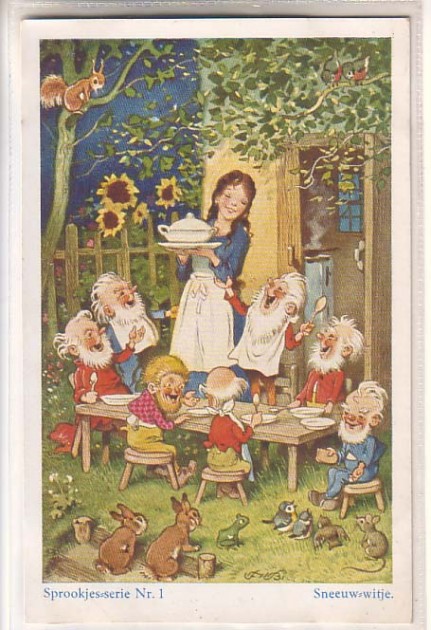
THIS ARTICLE iISUNDER RE-CONSTUCTION 10-13-2014
(With illustrations from the Stephen L. Smith collection of Fairy-tale “kinder” mugs).
Once upon a time in the middle of winter, when the flakes of snow were falling like feathers from the sky, a queen sat at a window sewing, and the frame of the window was made of black ebony. And whilst she was sewing and looking out of the window at the snow, she pricked her finger with the needle, and three drops of blood fell upon the snow. And the red looked pretty upon the white snow, and she thought to herself, would that I had a child as white as snow, as red as blood, and as black as the wood of the window-frame. Soon after that she had a little daughter, who was as white as snow, and as red as blood, and her hair was as black as ebony, and she was therefore called little Snow White. And when the child was born, the queen died. After a year had passed the king took to himself another wife. She was a beautiful woman, but proud and haughty, and she could not bear that anyone else could surpass her in beauty. She had a wonderful looking-glass, and when she stood in front of it and looked at herself in it, and said, “Looking-glass, looking-glass, on the wall, Who in this land is the fairest of all?” The looking-glass answered, “Thou, o queen, art the fairest of all.” Then she was satisfied, for she knew that the looking-glass spoke the truth. But Snow White was growing up, and grew more and more beautiful, and when she was seven years old she was as beautiful as the day, and more beautiful than the queen herself. And once when the queen asked her looking-glass, “Looking-glass, looking-glass, on the wall, Who in this land is the fairest of all?” It answered, “Thou art fairer than all who are here, lady queen. But more beautiful still is Snow White, as I ween. (sic)” Then the queen was shocked, and turned yellow and green with envy. From that hour, whenever she looked at Snow White, her heart heaved in her breast; she hated the girl so much. And envy and pride grew higher and higher in her heart like a weed, so that she had no peace day or night. She called a huntsman, and said, “Take the child away into the forest. I will no longer have her in my sight. Kill her, and bring me back her lung and liver as a token.” 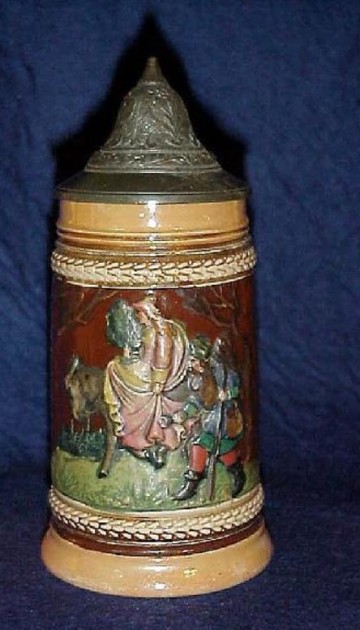 [ABOVE: There is some misinformation going around “the net” about this scene. Some have said it is the woodsman and Snow White, but what it really shows is (The Virgin) Mary on the donkey, with Joseph walking next to them on their way to Bethlehem (Hint: the Evergreen in her arms). Sometimes one needs more than one example of a kinder mug / stein to make the definition clearer. On one of mine with this scene on the front panel – the side panels are inscribed: [Left] “Den braven Kindern Freude” = “The good child’s joy (or pleasure)”. [Right] “Der Weihnachts mann macht heute” = “The Christmas eve man (Joseph) makes this day”] The huntsman obeyed, and took her away but when he had drawn his knife, and was about to pierce Snow White’s innocent heart, she began to weep, and said, “Ah dear huntsman, leave me my life. I will run away into the wild forest, and never come home again.” And as she was so beautiful the huntsman had pity on her and said, “Run away, then, you poor child.” “The wild beasts will soon have devoured you,” thought he, and yet it seemed as if a stone had been rolled from his heart since it was no longer needful for him to kill her. And as a young bear just then came running by he stabbed it, and cut out its lung and liver and took them to the queen as proof that the child was dead. The cook had to salt them, and the wicked queen ate them, and thought she had eaten the lung and liver of Snow White. But now the poor child was all alone in the great forest, and so terrified that she looked at all the leaves on the trees, and did not know what to do. Then she began to run, and ran over sharp stones and through thorns, and the wild beasts ran past her, but did her no harm. She ran as long as her feet would go until it was almost evening, then she saw a little cottage and went into it to rest herself.
[ABOVE: There is some misinformation going around “the net” about this scene. Some have said it is the woodsman and Snow White, but what it really shows is (The Virgin) Mary on the donkey, with Joseph walking next to them on their way to Bethlehem (Hint: the Evergreen in her arms). Sometimes one needs more than one example of a kinder mug / stein to make the definition clearer. On one of mine with this scene on the front panel – the side panels are inscribed: [Left] “Den braven Kindern Freude” = “The good child’s joy (or pleasure)”. [Right] “Der Weihnachts mann macht heute” = “The Christmas eve man (Joseph) makes this day”] The huntsman obeyed, and took her away but when he had drawn his knife, and was about to pierce Snow White’s innocent heart, she began to weep, and said, “Ah dear huntsman, leave me my life. I will run away into the wild forest, and never come home again.” And as she was so beautiful the huntsman had pity on her and said, “Run away, then, you poor child.” “The wild beasts will soon have devoured you,” thought he, and yet it seemed as if a stone had been rolled from his heart since it was no longer needful for him to kill her. And as a young bear just then came running by he stabbed it, and cut out its lung and liver and took them to the queen as proof that the child was dead. The cook had to salt them, and the wicked queen ate them, and thought she had eaten the lung and liver of Snow White. But now the poor child was all alone in the great forest, and so terrified that she looked at all the leaves on the trees, and did not know what to do. Then she began to run, and ran over sharp stones and through thorns, and the wild beasts ran past her, but did her no harm. She ran as long as her feet would go until it was almost evening, then she saw a little cottage and went into it to rest herself. 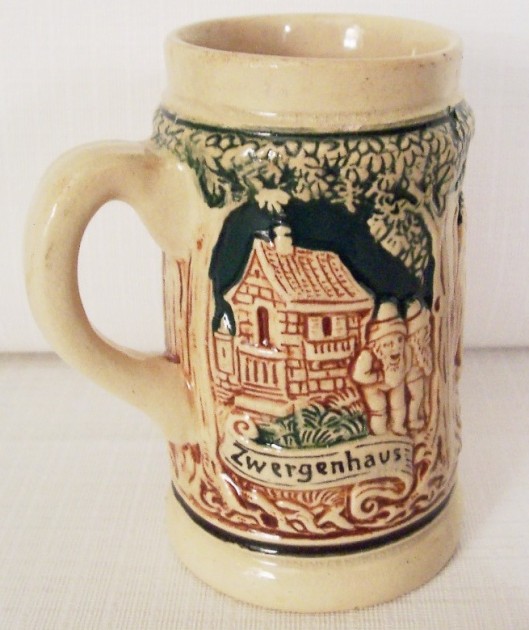 THE HOUSE OF THE 7 ZWERGS (DWARFS, OR GNOMES) ____________________________________________________________________________________________________________ Everything in the cottage was small, but neater and cleaner than can be told. There was a table on which was a white cover, and seven little plates, and on each plate a little spoon, moreover, there were seven little knives and forks, and seven little mugs. Against the wall stood seven little beds side by side, and covered with snow-white counterpanes. Little Snow White was so hungry and thirsty that she ate some vegetables and bread from each plate and drank a drop of wine out of each mug, for she did not wish to take all from one only. Then, as she was so tired, she laid herself down on one of the little beds, but none of them suited her, one was too long, another too short, but at last she found that the seventh one was right, and so she remained in it, said a prayer and went to sleep.
THE HOUSE OF THE 7 ZWERGS (DWARFS, OR GNOMES) ____________________________________________________________________________________________________________ Everything in the cottage was small, but neater and cleaner than can be told. There was a table on which was a white cover, and seven little plates, and on each plate a little spoon, moreover, there were seven little knives and forks, and seven little mugs. Against the wall stood seven little beds side by side, and covered with snow-white counterpanes. Little Snow White was so hungry and thirsty that she ate some vegetables and bread from each plate and drank a drop of wine out of each mug, for she did not wish to take all from one only. Then, as she was so tired, she laid herself down on one of the little beds, but none of them suited her, one was too long, another too short, but at last she found that the seventh one was right, and so she remained in it, said a prayer and went to sleep. 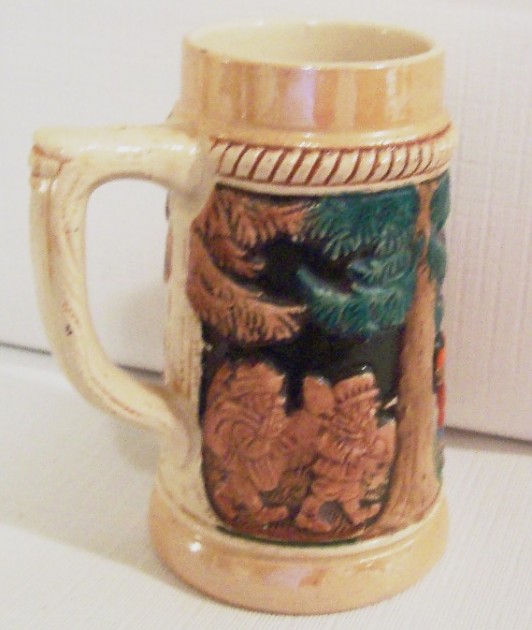 THE SEVEN DWARFS COMING HOME AFTER A DAY AT WORK AT THE MINES When it was quite dark the owners of the cottage came back! They were “seven dwarfs” who dug and delved in the mountains for ore. They lit their seven candles, and as it was now light within the cottage they saw that someone had been there, for everything was not in the same order in which they had left it. The first said, “Who has been sitting on my chair?” The second, “Who has been eating off my plate?” The third, “Who has been taking some of my bread?” The fourth, “Who has been eating my vegetables?” The fifth, “Who has been using my fork?” The sixth, “Who has been cutting with my knife?” The seventh, “Who has been drinking out of my beer stein?” Then the first looked round and saw that there was a little hollow on his bed, and he said, “Who has been getting into my bed?” The others came up and each called out, “Somebody has been lying in my bed too.” But the seventh when he looked at his bed saw little Snow White, who was lying asleep therein. And he called the others, who came running up, and they cried out with astonishment, and brought their seven little candles and let the light fall on little Snow White. “Oh, heavens, oh, heavens,” cried they, “what a lovely child.” And they were so glad that they did not wake her up, but let her sleep on in the bed. And the seventh dwarf slept with his companions, one hour with each, and so passed the night. When it was morning little Snow White awoke, and was frightened when she saw the seven dwarfs. But they were friendly and asked her what her name was. “My name is Snow White,” she answered. “How have you come to our house?” said the dwarfs. Then she told them that her step-mother had wished to have her killed, but that the huntsman had spared her life, and that she had run for the whole day, until at last she had found their dwelling. The dwarfs said, “If you will take care of our house, cook, make the beds, wash, sew and knit, and if you will keep everything neat and clean you can stay with us and you shall want for nothing.” “Yes,” said Snow White, “with all my heart.” And she stayed with them.
THE SEVEN DWARFS COMING HOME AFTER A DAY AT WORK AT THE MINES When it was quite dark the owners of the cottage came back! They were “seven dwarfs” who dug and delved in the mountains for ore. They lit their seven candles, and as it was now light within the cottage they saw that someone had been there, for everything was not in the same order in which they had left it. The first said, “Who has been sitting on my chair?” The second, “Who has been eating off my plate?” The third, “Who has been taking some of my bread?” The fourth, “Who has been eating my vegetables?” The fifth, “Who has been using my fork?” The sixth, “Who has been cutting with my knife?” The seventh, “Who has been drinking out of my beer stein?” Then the first looked round and saw that there was a little hollow on his bed, and he said, “Who has been getting into my bed?” The others came up and each called out, “Somebody has been lying in my bed too.” But the seventh when he looked at his bed saw little Snow White, who was lying asleep therein. And he called the others, who came running up, and they cried out with astonishment, and brought their seven little candles and let the light fall on little Snow White. “Oh, heavens, oh, heavens,” cried they, “what a lovely child.” And they were so glad that they did not wake her up, but let her sleep on in the bed. And the seventh dwarf slept with his companions, one hour with each, and so passed the night. When it was morning little Snow White awoke, and was frightened when she saw the seven dwarfs. But they were friendly and asked her what her name was. “My name is Snow White,” she answered. “How have you come to our house?” said the dwarfs. Then she told them that her step-mother had wished to have her killed, but that the huntsman had spared her life, and that she had run for the whole day, until at last she had found their dwelling. The dwarfs said, “If you will take care of our house, cook, make the beds, wash, sew and knit, and if you will keep everything neat and clean you can stay with us and you shall want for nothing.” “Yes,” said Snow White, “with all my heart.” And she stayed with them. 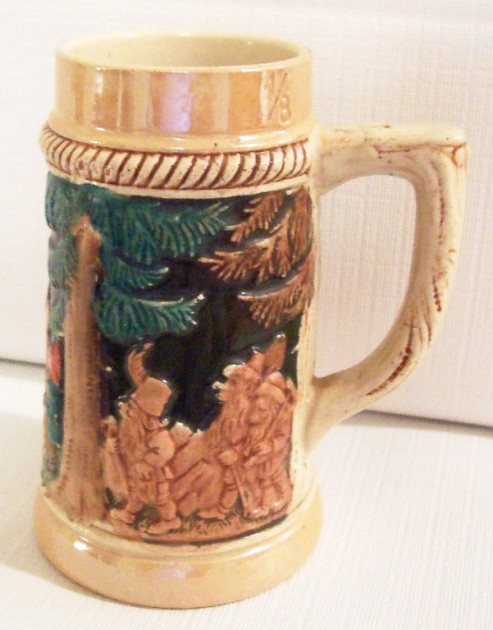 She kept the house in order for them. In the mornings they went to the mountains and looked for copper and gold, in the evenings they came back, and then their supper had to be ready
She kept the house in order for them. In the mornings they went to the mountains and looked for copper and gold, in the evenings they came back, and then their supper had to be ready 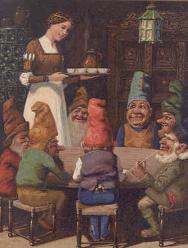 (Illustration ►not on a kinder mug.) The girl was alone the whole day, so the good dwarfs warned her and said, “Beware of your step-mother, she will soon know that you are here, be sure to let no one come in.” But the queen, believing that she had eaten Snow White’s lung and liver, could not but think that she was again the first and most beautiful of all, and she went to her looking-glass and said, “Looking-glass, looking-glass, on the wall, Who in this land is the fairest of all?” And the glass answered, “Oh, queen, thou art fairest of all I see, But over the hills, where the seven dwarfs dwell, Snow White is still alive and well, And none is so fair as she.” Then she was astounded, for she knew that the looking-glass never spoke falsely, and she knew that the huntsman had betrayed her, and that little Snow White was still alive. And so she thought and thought again how she might kill her, for so long as she was not the fairest in the whole land, envy let her have no rest. And when she had at last thought of something to do, she painted her face, and dressed herself like an old peddler-woman, and no one could have known her. In this disguise she went over the seven mountains to the seven dwarfs, and knocked at the door and cried, “Pretty things to sell, very cheap, very cheap.” Little Snow White looked out of the window and called out, “Good-day my good woman, what have you to sell?” “Good things, pretty things,” she answered, “stay-laces of all colors,” and she pulled out one which was woven of bright-colored silk. “I may let the worthy old woman in,” thought Snow White, and she unbolted the door and bought the pretty laces. “Child,” said the old woman, “what a fright you look, come, I will lace you properly for once.” Snow White had no suspicion, but stood before her, and let herself be laced with the new laces. But the old woman laced so quickly and so tightly that Snow White lost her breath and fell down as if dead. “You were the most beautiful,” said the queen to herself, and ran away. Not long afterwards, in the evening, the seven dwarfs came home, but how shocked they were when they saw their dear little Snow White lying on the ground, and that she neither stirred nor moved, and seemed to be dead. They lifted her up, and, as they saw that she was laced too tightly, they cut the laces, then she began to breathe a little, and after a while came to life again.
(Illustration ►not on a kinder mug.) The girl was alone the whole day, so the good dwarfs warned her and said, “Beware of your step-mother, she will soon know that you are here, be sure to let no one come in.” But the queen, believing that she had eaten Snow White’s lung and liver, could not but think that she was again the first and most beautiful of all, and she went to her looking-glass and said, “Looking-glass, looking-glass, on the wall, Who in this land is the fairest of all?” And the glass answered, “Oh, queen, thou art fairest of all I see, But over the hills, where the seven dwarfs dwell, Snow White is still alive and well, And none is so fair as she.” Then she was astounded, for she knew that the looking-glass never spoke falsely, and she knew that the huntsman had betrayed her, and that little Snow White was still alive. And so she thought and thought again how she might kill her, for so long as she was not the fairest in the whole land, envy let her have no rest. And when she had at last thought of something to do, she painted her face, and dressed herself like an old peddler-woman, and no one could have known her. In this disguise she went over the seven mountains to the seven dwarfs, and knocked at the door and cried, “Pretty things to sell, very cheap, very cheap.” Little Snow White looked out of the window and called out, “Good-day my good woman, what have you to sell?” “Good things, pretty things,” she answered, “stay-laces of all colors,” and she pulled out one which was woven of bright-colored silk. “I may let the worthy old woman in,” thought Snow White, and she unbolted the door and bought the pretty laces. “Child,” said the old woman, “what a fright you look, come, I will lace you properly for once.” Snow White had no suspicion, but stood before her, and let herself be laced with the new laces. But the old woman laced so quickly and so tightly that Snow White lost her breath and fell down as if dead. “You were the most beautiful,” said the queen to herself, and ran away. Not long afterwards, in the evening, the seven dwarfs came home, but how shocked they were when they saw their dear little Snow White lying on the ground, and that she neither stirred nor moved, and seemed to be dead. They lifted her up, and, as they saw that she was laced too tightly, they cut the laces, then she began to breathe a little, and after a while came to life again. 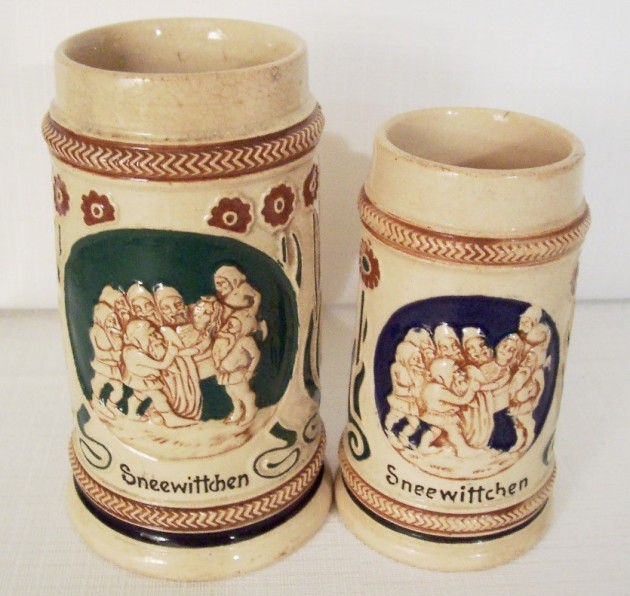 SNOW WHITE [SNEEWITTCHEN] COMES BACK TO LIFE THE FIRST TIME , AFTER THE GNOMES CUT HER LACES ______________________________________________________________________________________ When the dwarfs heard what had happened they said, “The old peddler-woman was no one else than the wicked queen, take care and let no one come in when we are not with you.” But the wicked woman when she had reached home went in front of the glass and asked, “Looking-glass, looking-glass, on the wall, Who in this land is the fairest of all?” And it answered as before, “Oh, queen, thou art fairest of all I see, But over the hills, where the seven dwarfs dwell, Snow White is still alive and well, And none is so fair as she.” When she heard that, all her blood rushed to her heart with fear, for she saw plainly that little Snow White was again alive. “But now,” she said, “I will think of something that shall really put an end to you.” And by the help of witchcraft, which she understood, she made a poisonous comb. Then she disguised herself and took the shape of another old woman. So she went over the seven mountains to the seven dwarfs, knocked at the door, and cried, “Good things to sell, cheap, cheap.” Little Snow White looked out and said, “Go away, I cannot let anyone come in.” “I suppose you can look,” said the old woman, and pulled the poisonous comb out and held it up. It pleased the girl so well that she let herself be beguiled, and opened the door. When they had made a bargain the old woman said, “Now I will comb you properly for once.” Poor little Snow White had no suspicion, and let the old woman do as she pleased, but hardly had she put the comb in her hair than the poison in it took effect, and the girl fell down senseless. “You paragon of beauty,” said the wicked woman, “you are done for now, and she went away.” But fortunately it was almost evening, when the seven dwarfs came home. When they saw Snow White lying as if dead upon the ground they at once suspected the step-mother, and they looked and found the poisoned comb. Scarcely had they taken it out when Snow White came to herself, and told them what had happened. Then they warned her once more to be upon her guard and to open the door to no one.
SNOW WHITE [SNEEWITTCHEN] COMES BACK TO LIFE THE FIRST TIME , AFTER THE GNOMES CUT HER LACES ______________________________________________________________________________________ When the dwarfs heard what had happened they said, “The old peddler-woman was no one else than the wicked queen, take care and let no one come in when we are not with you.” But the wicked woman when she had reached home went in front of the glass and asked, “Looking-glass, looking-glass, on the wall, Who in this land is the fairest of all?” And it answered as before, “Oh, queen, thou art fairest of all I see, But over the hills, where the seven dwarfs dwell, Snow White is still alive and well, And none is so fair as she.” When she heard that, all her blood rushed to her heart with fear, for she saw plainly that little Snow White was again alive. “But now,” she said, “I will think of something that shall really put an end to you.” And by the help of witchcraft, which she understood, she made a poisonous comb. Then she disguised herself and took the shape of another old woman. So she went over the seven mountains to the seven dwarfs, knocked at the door, and cried, “Good things to sell, cheap, cheap.” Little Snow White looked out and said, “Go away, I cannot let anyone come in.” “I suppose you can look,” said the old woman, and pulled the poisonous comb out and held it up. It pleased the girl so well that she let herself be beguiled, and opened the door. When they had made a bargain the old woman said, “Now I will comb you properly for once.” Poor little Snow White had no suspicion, and let the old woman do as she pleased, but hardly had she put the comb in her hair than the poison in it took effect, and the girl fell down senseless. “You paragon of beauty,” said the wicked woman, “you are done for now, and she went away.” But fortunately it was almost evening, when the seven dwarfs came home. When they saw Snow White lying as if dead upon the ground they at once suspected the step-mother, and they looked and found the poisoned comb. Scarcely had they taken it out when Snow White came to herself, and told them what had happened. Then they warned her once more to be upon her guard and to open the door to no one. 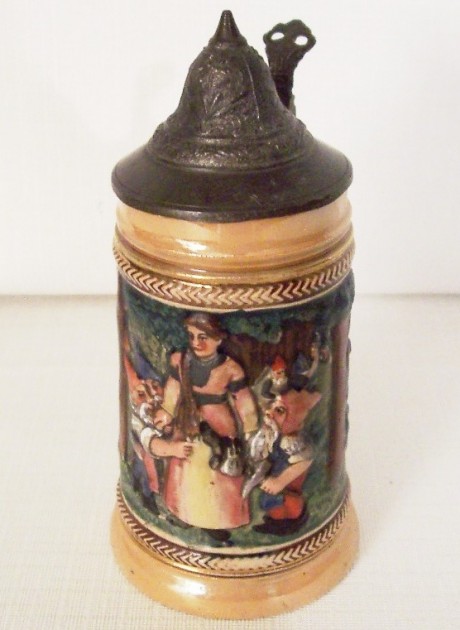 SNOW WHITE, NOW ALIVE FOR THE SECOND TIME, THANKING HER DWARFS . The queen, at home, went in front of the glass and said, “Looking-glass, looking-glass, on the wall, Who in this land is the fairest of all?” Then it answered as before, “Oh, queen, thou art fairest of all I see, But over the hills, where the seven dwarfs dwell, Snow White is still alive and well, And none is so fair as she.” When she heard the glass speak thus she trembled and shook with rage. “Snow White shall die,” she cried, “even if it costs me my life.” Thereupon she went into a quite secret, lonely room, where no one ever came, and there she made a very poisonous apple. Outside it looked pretty, white with a red cheek, so that everyone who saw it longed for it, but whoever ate a piece of it must surely die. When the apple was ready she painted her face, and dressed herself up as a farmer’s wife, and so she went over the seven mountains to the seven dwarfs. She knocked at the door. Snow White put her head out of the window and said, “I cannot let anyone in, the seven dwarfs have forbidden me.” “It is all the same to me,” answered the woman, “I shall soon get rid of my apples. There, I will give you one.” “No,” said Snow White, “I dare not take anything.” “Are you afraid of poison?” said the old woman, “look, I will cut the apple in two pieces, you eat the red cheek, and I will eat the white.” The apple was so cunningly made that only the red cheek was poisoned. Snow White longed for the fine apple, and when she saw that the woman ate part of it she could resist no longer, and stretched out her hand and took the poisonous half. But hardly had she a bit of it in her mouth than she fell down dead. Then the queen looked at her with a dreadful look, and laughed aloud and said, “White as snow, red as blood, black as ebony-wood, this time the dwarfs cannot wake you up again.” And when she asked of the looking-glass at home, “Looking-glass, looking-glass, on the wall, Who in this land is the fairest of all?” And it answered at last, “Oh, queen, in this land thou art fairest of all.” Then her envious heart had rest, so far as an envious heart can have rest. The dwarfs, when they came home in the evening, found Snow White lying upon the ground, she breathed no longer and was dead. They lifted her up, looked to see whether they could find anything poisonous, unlaced her, combed her hair, washed her with water and wine, but it was all of no use, the poor child was dead, and remained dead. They laid her upon a bier, and all seven of them sat round it and wept for her, and wept three days long. Then they were going to bury her, but she still looked as if she were living, and still had her pretty red cheeks.
SNOW WHITE, NOW ALIVE FOR THE SECOND TIME, THANKING HER DWARFS . The queen, at home, went in front of the glass and said, “Looking-glass, looking-glass, on the wall, Who in this land is the fairest of all?” Then it answered as before, “Oh, queen, thou art fairest of all I see, But over the hills, where the seven dwarfs dwell, Snow White is still alive and well, And none is so fair as she.” When she heard the glass speak thus she trembled and shook with rage. “Snow White shall die,” she cried, “even if it costs me my life.” Thereupon she went into a quite secret, lonely room, where no one ever came, and there she made a very poisonous apple. Outside it looked pretty, white with a red cheek, so that everyone who saw it longed for it, but whoever ate a piece of it must surely die. When the apple was ready she painted her face, and dressed herself up as a farmer’s wife, and so she went over the seven mountains to the seven dwarfs. She knocked at the door. Snow White put her head out of the window and said, “I cannot let anyone in, the seven dwarfs have forbidden me.” “It is all the same to me,” answered the woman, “I shall soon get rid of my apples. There, I will give you one.” “No,” said Snow White, “I dare not take anything.” “Are you afraid of poison?” said the old woman, “look, I will cut the apple in two pieces, you eat the red cheek, and I will eat the white.” The apple was so cunningly made that only the red cheek was poisoned. Snow White longed for the fine apple, and when she saw that the woman ate part of it she could resist no longer, and stretched out her hand and took the poisonous half. But hardly had she a bit of it in her mouth than she fell down dead. Then the queen looked at her with a dreadful look, and laughed aloud and said, “White as snow, red as blood, black as ebony-wood, this time the dwarfs cannot wake you up again.” And when she asked of the looking-glass at home, “Looking-glass, looking-glass, on the wall, Who in this land is the fairest of all?” And it answered at last, “Oh, queen, in this land thou art fairest of all.” Then her envious heart had rest, so far as an envious heart can have rest. The dwarfs, when they came home in the evening, found Snow White lying upon the ground, she breathed no longer and was dead. They lifted her up, looked to see whether they could find anything poisonous, unlaced her, combed her hair, washed her with water and wine, but it was all of no use, the poor child was dead, and remained dead. They laid her upon a bier, and all seven of them sat round it and wept for her, and wept three days long. Then they were going to bury her, but she still looked as if she were living, and still had her pretty red cheeks. They said, “We could not bury her in the dark ground,” and they had a transparent coffin of glass made, so that she could be seen from all sides, and they laid her in it, and wrote her name upon it in golden letters, and that she was a king’s daughter. Then they put the coffin out upon the mountain, and one of them always stayed by it and watched it. And birds came too, and wept for Snow White, first an owl, then a raven, and last a dove. And now Snow White lay a long, long time in the coffin, and she did not change, but looked as if she were asleep, for she was as white as snow, as red as blood, and her hair was as black as ebony. It happened, however, that a king’s son came into the forest, and went to the dwarfs, house to spend the night. He saw the coffin on the mountain, and the beautiful Snow White within it, and read what was written upon it in golden letters. Then he said to the dwarfs, “Let me have the coffin, I will give you whatever you want for it.” But the dwarfs answered, “We will not part with it for all the gold in the world.” Then he said, “Let me have it as a gift, for I cannot live without seeing Snow White. I will honor and prize her as my dearest possession.” As he spoke in this way the good dwarfs took pity upon him, and gave him the coffin. And now the king’s son had it carried away by his servants on their shoulders. And it happened that they stumbled over a tree-stump, and with the shock the poisonous piece of apple which Snow White had bitten off came out of her throat. And before long she opened her eyes, lifted up the lid of the coffin, sat up, and was once more alive.
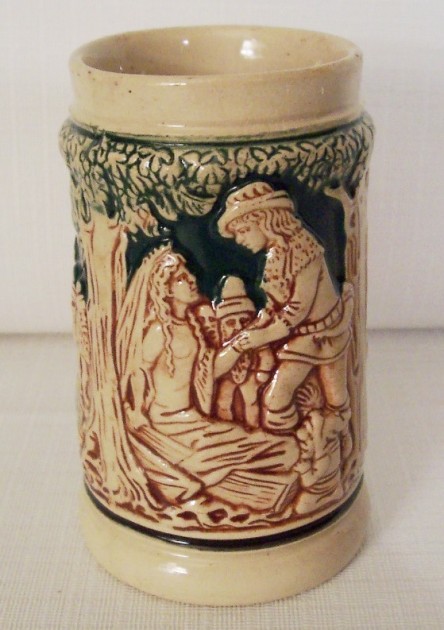 THE PRINCE HAS WAKENED SNOW WHITE WITH A KISS, AND SHE IS TALKING TO HIM. “Oh, heavens, where am I?” she cried. The king’s son, full of joy, said, “You are with me.” And he told her what had happened, and said, “I love you more than everything in the world, come with me to my father’s palace, you shall be my wife!
THE PRINCE HAS WAKENED SNOW WHITE WITH A KISS, AND SHE IS TALKING TO HIM. “Oh, heavens, where am I?” she cried. The king’s son, full of joy, said, “You are with me.” And he told her what had happened, and said, “I love you more than everything in the world, come with me to my father’s palace, you shall be my wife! 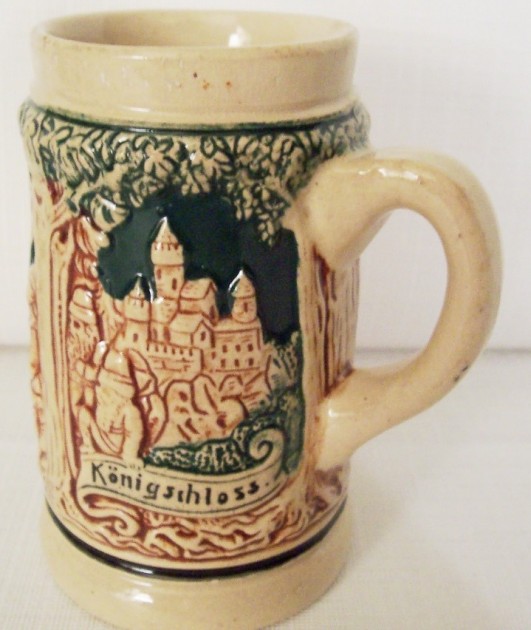 THE KING’S PALACE (Konigschloss) And Snow White was willing, and went with him, and their wedding was held with great show and splendor. But Snow White’s wicked step-mother was also bidden to the feast. When she had arrayed herself in beautiful clothes she went before the looking-glass, and said, “Looking-glass, looking-glass, on the wall, Who in this land is the fairest of all?” The glass answered, “Oh, queen, of all here the fairest art thou, But the young queen is fairer by far as I trow (sic) .” Then the wicked woman uttered a curse, and was so wretched, so utterly wretched that she knew not what to do. At first she would not go to the wedding at all, but she had no peace, and had to go to see the young queen. And when she went in she recognized Snow White, and she stood still with rage and fear, and could not stir. But iron slippers had already been put upon the fire, and they were brought in with tongs, and set before her. Then she was forced to put on the red-hot shoes, and dance until she dropped down dead. XXXXXXXXXXXXXXXXXXXXXXXXXXXXXXXXXXXXXXXXXXXXXXXXXXXXXXXXXXXXXXXXX
THE KING’S PALACE (Konigschloss) And Snow White was willing, and went with him, and their wedding was held with great show and splendor. But Snow White’s wicked step-mother was also bidden to the feast. When she had arrayed herself in beautiful clothes she went before the looking-glass, and said, “Looking-glass, looking-glass, on the wall, Who in this land is the fairest of all?” The glass answered, “Oh, queen, of all here the fairest art thou, But the young queen is fairer by far as I trow (sic) .” Then the wicked woman uttered a curse, and was so wretched, so utterly wretched that she knew not what to do. At first she would not go to the wedding at all, but she had no peace, and had to go to see the young queen. And when she went in she recognized Snow White, and she stood still with rage and fear, and could not stir. But iron slippers had already been put upon the fire, and they were brought in with tongs, and set before her. Then she was forced to put on the red-hot shoes, and dance until she dropped down dead. XXXXXXXXXXXXXXXXXXXXXXXXXXXXXXXXXXXXXXXXXXXXXXXXXXXXXXXXXXXXXXXXX 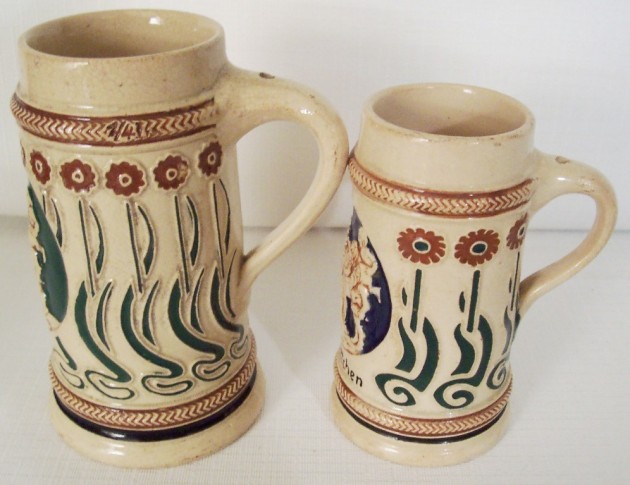 DETAIL OF DIIFERENCES IN THE ART NOUVEAU FLOWER DESIGN ON THE ‘SNEEWITCHEN’ KINDER MUGS SHOWN ABOVE ___________________________________________________________________________________________________________ (English translation by Margaret Hunt) (STORY FROM: http://www.fln.vcu.edu/grimm/schneeeng.html) This article (not the Grimm’s translation) Copyright 5-08-06 by Stephen L. Smith [END OF ART [END – SOK – 21 – DD]
DETAIL OF DIIFERENCES IN THE ART NOUVEAU FLOWER DESIGN ON THE ‘SNEEWITCHEN’ KINDER MUGS SHOWN ABOVE ___________________________________________________________________________________________________________ (English translation by Margaret Hunt) (STORY FROM: http://www.fln.vcu.edu/grimm/schneeeng.html) This article (not the Grimm’s translation) Copyright 5-08-06 by Stephen L. Smith [END OF ART [END – SOK – 21 – DD]  “Life is sexually transmitted!”
“Life is sexually transmitted!”

Leave a Reply